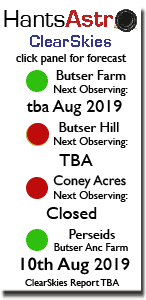Clear Dark Skies...
To assist your planning of observing nights is the rollout of our ClearSkies service.
Please keep checking this site and the links to keep updated on the weather, by clicking the ClearSkies panel on the right. It's a work-in-progress so please contact us if you think we can add to it and make it better.
HantsAstro is doing something that a lot of amateur astronomers in the UK thought couldn't work: locating dark sky sites in the South of England that are good enough and consistent enough for deep sky observation and astrophotography.
Let me tell you that they do exist, as we now know how to find them and have located several in Hampshire and across the South of England, often in the most surprising places.
Using a Unihedron Sky Quality Meter, I was getting readings of dark sky sites of Mag 20+Arc/second consistently from several locations. Though a lot depends on weather, and recently the South has had some really extraordinary clear nights. Best nights are cold below 4°C and after rain. The less the stars twinkle, the better the seeing as there is less disturbance, from warmer air cells.
Looking South out over the English Channel, but coastal sites are often windy and can play havoc with lighter or larger telescopes. From Poole in Dorset to Eastbourne, there is light pollution nearly unbroken along the coast. Inland is better, but you have to be at least 10 miles (as the crow flies) from any major town/city before the light pollution decreases.
Look at any map and you'll see that finding a suitable dark skies site in the South is harder than you first think.
Wiltshire is good and North Dorset is better, as well as North Hamphire up to and around the M3 Motorway. Andover and Basingstoke astro societies have some great skies, as does Cody AS. Garthowen matches these vistas well, with Mag 20+.
The Hampshire Astronomical Group have what is probably the largest, and arguably the best, amateur astronomical observatory in the UK. It's near Clanfield, 10 miles north of Portsmouth and has good skies too, regularly getting to Mag 19.6 - Mag 20 per Arc/Sec. Our Butser site, a couple of miles away, just exceeds this because of the shielding of Windmill Hill from the South with Butser Hill and Queen Elizabeth Country Park to its North-west and East.
Southampton and Solent AS have views that can be marred by typical light pollution from the coast on a bad night, but they are fine for general observing. Our observing site at WSC improves on this, purely because it's further away from the coast; only the last stretch of the A272 road affects our viewing. We have had Mag 20 nights there!
Vectis on the Isle of Wight have some truly stunning skies at their annual IOW Star Party held in March every year, and boast skies of Mag 20.3 - 21.5, some of the darkest in the country! Each level of magnitude is 100 times darker than the previous. So the differences may appear small on paper but are easy to see when you're there.
Currently we have two active sites, Butser Ancient Farm, near Chalton and WSC, Science Centre & Planetarium, Winchester. We are also developing other sites for future use in the county and are discovering further sites across the South for away missions.
We are always on the lookout as a group to identify new sites, such is our zeal for escaping light pollution. One day the lights will go out, but it will be driven by economic rather than environmental reasons.
We now have a selection of windbreaks, tents, gazebos and a marquee for field use at events to make the most of our observing time. HantAstro astronomers certainly get a lot of fresh air... astronomy nomads?
Maybe.
HantsAstro will keep you posted on our observing sites and activities via our eZine 'Look Up!'
David Woods
HantsAstro




